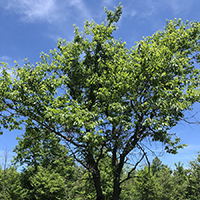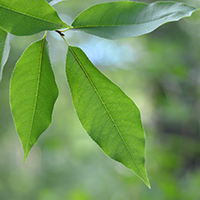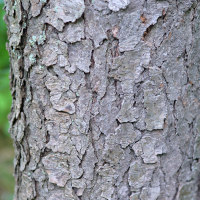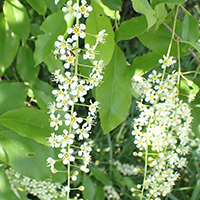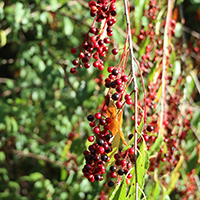What black cherry looks like
Size and shape
- Can grow to 22 metres tall.
- Trunk is about 60 centimetres in diameter.
Leaves
- Shiny bright green on top and paler underneath.
- Narrow and pointed at the end (5 to 15 centimetres long).
Bark
- Dark grey and flaky on mature trees.
- Reddish-brown and smooth with horizontal grey lines on young trees.
Flowers
- Bunches of small white flowers grow in the spring after the first leaves have fully developed.
Fruit
- Dark red cherries grow in clusters from August to early September (8 to 10 millimetres across).
Where black cherry is found
Black cherry grows across Southern Ontario.
What you need to know to grow black cherry
- Moisture: tolerates a variety of moisture levels.
- Soil: grows in a variety of soils.
- Shade: grows best in full sun.
- Cautions: when grown in cooler temperatures, black cherry will be more shrub-like
Benefits and uses of black cherry
Wildlife benefits
Black cherry is an important forest tree for wildlife. Many bird and mammal species eat its fruit.
Commercial uses
Black cherry has historically been a popular choice for fine carpentry due to its workability and unique colour. It is commonly used in:
- cabinetry
- interior finishes, including flooring and trim
- furniture
- musical instruments
Black cherry trees are a great ornamental tree with their attractive flowers and berries. Black cherry fruit (black cherries) can also be used as flavouring in alcoholic beverages and jams.
Fun facts about black cherry
- Black cherries are edible but very bitter.
- Black cherry leaves smell like almonds when crushed.
- Black cherry can be grown as a shrub by cutting it to the ground every 2 to 3 years.
Updated: January 10, 2024
Published: July 18, 2014
